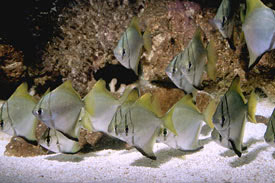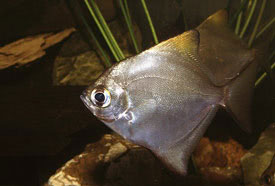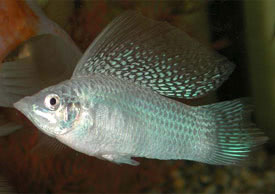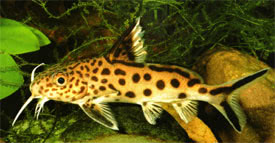
 Magyarul / Hungarian
Magyarul / Hungarian



- Scientific name: Monodactylus argenteus
- Common name: Fingerfish, False angelfish, Malaysian angelfish, Silver mono
- Group: Brackish fishes
- Habitat: Southeast Asia, Australia, East African Coast
- Size: 20 cm
- Biotope: In coastal lakes, estuaries, rivers, and lagoons in fresh, brackish, and sea water. Occasionally inhabits salt water reefs.
- Social behavior: The Mono can be combined with other large, hardy brackish water species. Smallfish may be eaten.Monos are timid and easily frightened, and should not be combined with substantially largerfish.A schooling fish by nature that should be kept in groups of at least five.
- Diet: Live, small fish, small crabs, shrimp, worms, insect larvae, pellets, peas, lettuce, spinach, flakes, plant debris.
- Breeding: Unsuccessful in captivity.
- Tank: Minimum 500 litres
- Population: 5-6 fishes for 500 litres
- Decoration: Plants tolerant of brackish water may be used, although the Mono may nibble on their leaves. Use a substrate of fine gravel, or preferably coral sand. Use an efficient filter for this greedy eater.
- Temperature: 25-28 °C
- pH: 7,5-8,5
- Hardness: 10-20NK°
- Salinity: 10-32%
- Lifespan: 5-8 years
Description: A tall, disc-shaped fish with lateral compression. The head is small, as is the mouth. The eyes are large and have a black band running through them. The dorsal and anal fins are almost oppositeone other and the edge of the caudal fin is straight. The body is silver to white in color while the dorsal and caudal finsare green to orange to yellow.The front edge of the anal fin is black. Young often have a black line running across thegill cover connecting with the black of the anal fin.
The Mono Argentus spawns in the saltwater of the ocean, but the difference between the sexes and their breeding habits are unknown. Gradual change from brackish to saltwater will maximize the coloration and health of the fish as they become older.





















